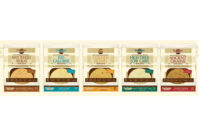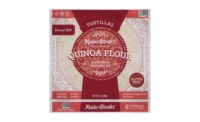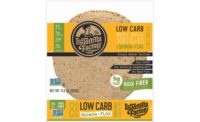This year, the tortilla market has had its share of ups and downs. But the market is rebounding, experiencing stronger growth, and is becoming one of the fastest growing segments in the baking industry, despite harsh weather and escalating commodities prices.
Despite the rising prices of corn, due in large part to news related to energy supplies and the role of alternative fuels, the tortilla market is growing, and the taco shell is riding high, more popular than ever. Food producers are striving to expand the varieties of tortillas available on the market and have been introducing not only specially flavored varieties but also finished frozen foods incorporating tortillas, which cater to consumers who want more convenience or who are short on time. As U.S. consumers become more health-conscious and want healthier food choices, lower carbohydrate, higher protein and higher-fiber tortilla products are coming to the market.
While the cost of commodities used in making tortillas has surged, Latinos have been largely responsible for a stronger share of consumer buying power in the United States, accounting for more than 9% of total buying power in 2009, compared to less than 4% in 1980, based on data estimates from market research publisher Packaged Facts. According to reports from the U.S. Census Bureau, the Hispanic population grew four times faster than the total population between 2000 and 2010.
Hispanics’ buying power in 2010 exceeded $1 trillion, and the population includes a significant number of high-income households, according to Packaged Facts. With an estimated buying power of $616 billion, Latinos of Mexican heritage represent the single most influential segment of the Hispanic market. By 2015, Packaged Facts forecasts that the buying power of the Latino population as a whole will reach $1.3 trillion. But, tortillas are also being consumed more and more by non-Hispanic consumers, thus fueling the high-energy growth. Hurried consumers continue to consume fast foods of which a major segment is Mexican food.
“While there is a great deal of disagreement regarding the economy, including the nature and extent of any recovery from the recession, the trends are very clear in one sector: The tortilla industry has grown from $6 billion a year just a few years ago to an estimated $11 billion by the end of this year., says Jim Kabbani, chief executive officer of the Tortilla Industry Association (TIA), Arlington, Va.
Buying locally or ‘at the deli’
This year, tortilla marketers and manufacturers rolled out new products developed to cater to a healthier lifestyle with whole wheat, lower-fat and high-fiber offerings, as well as products that cater to the non-Hispanic sector.
A visit to the Big Apple inspired Blue Marble Brands, Providence, R.I., to launch a Tumaro’s line of New York Deli Style wraps, inspired by the flavors abundant in New York’s legendary delis. And while deli foods aren’t often associated with better-for-you benefits, the five varieties—Rye, Pumpernickel, Sour Dough, Everything and Cracked Pepper—offer bold, authentic wrap flavors common with gourmet deli bread. Plus, these 10-in. wraps are is 96% fat-free, cholesterol-free, high in fiber and deliver 100 calories or less, says the company.
“We love the bread and bagels we find in New York delis, so we wanted to create a line for Tumaro’s that delivers those classic varieties in a convenient, wholesome wrap,” says Chris Test, president of Blue Marble Brands. “Packed with fiber…the New York Deli Style Wraps are true to the original breads while helping our customers maintain a healthy lifestyle.”
According to Testa, Tumaro’s was the first brand to introduce flavored tortillas to the market, including Jalapeño & Cilantro, Rosemary & Olive Oil and Roasted Red Pepper. Blue Marble also produces 8-in. flavored tortillas, 10-in. wraps, soy-full Heart Tortillas and low-carb versions, boasting zero trans-fat and cholesterol-free label claims and are kosher certified.
Blue Marble’s packaging also is changing, Testa adds, because the company wants Tumaro’s to be the primary choice for the healthy, discerning consumer. “We want to draw attention to the benefits Tumaro’s has,” he says.
Despite all of the varieties, Testa insists that flavors aren’t changing. “We continue to define ourselves by innovation with the New York Deli Style Wraps. We’ve seen more and more competitors adopt these same flavors, but they aren’t really anything new or innovative.
“In general, the sales of standard tortillas—basic corn or flour tortillas—are flat,” Testa admits. “Some companies are playing a value game, simply selling the most tortillas for the least amount of value. Although they have massive volume, sales are flat. It’s a billion dollar category, so certainly tortillas have become mainstream. Products that are multigrain, low-carb, functional, gluten-free, etc., are really raising the bar on innovation and health.”
He says that Blue Marble is consumer-driven company that wants each of its brands to reflect what’s going on in a consumer’s mind. “Tortillas and wraps have been an alternative for sliced bread and rolls for years. Now that the market is becoming more mature, consumers are raising the bar. Having gluten-free options or having the Whole Grains Council certify tortillas, or offering multigrain, low-carb products or products made with flaxseed, are in response to consumers asking for more healthy benefits from their tortillas and wraps.”
Blue Marble’s biggest challenge is merchandising, Testa says. “The tortilla category was developed in the ethnic, TexMex section. As consumers look for bread alternatives, they are not shopping that aisle. Our challenge is to get our products placed in the deli area or in a secondary display. Our New York Deli Style Wrap line belongs in the deli aisle. It doesn’t [belong] below in the taco section. That’s our biggest challenge.”
Going mainstream?
French Meadow Bakery, Minneapolis, disagrees with the tortilla market being flat. “It’s experiencing tremendous growth during the past year,” says Emily Dingmann, marketing coordinator. “The market is now a mainstream consumer product expectation. In response, French Meadow Bakery is pleased to offer gluten-free tortillas and sprouted grain tortillas for consumers. Traditional corn and flour tortillas have been in demand for many years, but now consumers are expecting a wider variety of grains incorporated into products. We have experienced an extremely positive reception to both our gluten-free tortillas and sprouted grain tortillas.”
Both products are two of the most versatile products French Meadow offers. Dingmann says some of the consumer trends driving such growth in the tortilla market are certain dietary needs and the gluten-free surge. “Today, those with specific dietary needs are able to enjoy tortillas and all of the many ways they can be incorporated into a nutritious diet,” she says. “Our tortilla tastes like traditional flour tortillas.”
Additionally, Jerry Chizick, vice president and general manager of Handi Foods Ltd., a Canadian baker of Mediterranean fresh, frozen and double-baked snack foods and baked goods such as pita products, crisps, pita bagels, flatbreads, pizza crusts, crackers, pita chips and more, agrees that tortillas are going mainstream.
“It’s happening. Some of the new trends are developing in the tortilla market because the Hispanic population is growing nationally,” he says. “Flavors and ingredients are changing—some more ethnic ingredients and some that are being used because of growing nutritional concerns. As tortillas become more mainstream, non-Hispanics are finding new uses. Much like the bagel, which was more ethnic years ago, several varieties have come into being to cater to the mass market.”
Wheat is still one of the best values of nutrition, Chizick says. “And we expect the number of whole-grain [products] to continue to increase. We are also testing low-sodium product developments. Breads are a low-cost staple and consumers get a good degree of their sodium from bread due to the volume consumed. So several bakers are trying to reduce sodium.”
Shelf life has become a real issue, he says particularly with respect to global warming, which causes products to mold faster. “And regulations are creating significant challenges for smaller operations, which find it difficult to keep up and manage or risk being left out of the market. Those are our biggest challenges. But we think flatbreads are gaining in popularity as a low-cost option,” Chizick adds.
At Don Pancho Authentic Mexican Foods, Salem, Ore., president Ricardo Baez says that he doesn’t feel tortillas have become a weekly staple in the non-Hispanic shopping basket, but are certainly becoming an increased option due to their versatility at home. “With the increased demand for whole-grain products, I can see tortillas becoming a true, mainstream option in this country,” he states.
New trends in the tortilla market closely follow what’s happening in the bread industry, Baez says. “There is a tremendous emphasis in developing tortillas that have a higher nutritional content, lower sodium and more fiber, that still taste great. Snack and bakery tortillas are following along the same lines as [bread] with multigrain, ancient grains, high fiber and low sodium. We work with bakery products in tortillas and have a fried chip line to incorporate these two applications.”
Baez agrees that flavors in the category are changing. “And ingredients are also changing to reflect the fact that tortillas are a universal carrier of great food from around the world,” he adds. “We now have new flavors such as curry, Italian Parmesan, blue cheese, cheesy jalapeño, Roma Tomato, Wasabi and Ranch-flavored wraps amongst others.”
Don Pancho’s lineup of new products use the tortilla as a carrier for food from around the world. The company developed a line of exotic flavors with reduced sodium to meet this demand. It also has a family of tortillas sold at retail that feature lower sodium and lower calories with additional pliability and flexibility. For whole-grain enthusiasts, there are items such ancient grain and multigrain tortilla wraps with lower sodium, high fiber and “a wonderful array of good-for-you ingredients,” according to Baez.
Bright future in the bread aisle
“Tortillas and flatbread have a bright future in the bread aisle…Consumers are looking not only to purchase a great-tasting tortilla, but to use tortillas as a way to incorporate additional nutrition to their diets, and make burritos, quesadillas, sandwich wraps, tacos, pita sandwiches, flatbread sandwiches or snacks,” Baez says. “We introduced a gluten-free tortilla to recognize this market. It will take time to develop this niche market, and distribution will be a key to success in the gluten-free category. There is tremendous interest in multigrain tortillas, ancient grain tortillas, low-sodium tortillas, high-fiber tortillas and reduced-calorie tortillas.”
Don Pancho also developed a line of low-sodium tortillas with a reduced calorie content that will roll to market soon, and is redesigning its packaging to reflect the added benefits of the ingredients in the tortillas.
Baez points to the issues of food safety, traceability, recall programs, ingredient declarations and other factors that contribute to the tortilla industry’s biggest challenges and opportunities. “It’s important to ensure that all of the folks involved, from suppliers to distributors, understand that it is our collective responsibility to provide a product that is safe to our consumers,” he says. “Shelf life has been and always will be important in the tortilla industry. We need to manufacture and distribute a product that will provide the consumer a wonderful experience. Ingredients are being developed to extend shelf life and on the equipment side, our equipment suppliers are building equipment that is easier to clean and with better materials. And just as important, the continued training of staff to ensure equipment is always clean, well maintained and always making sure we follow good manufacturing practices.”
Nearly every home purchases tortillas, says Greg Bingham, vice president of Don Julio Foods Inc./Clover Club Foods, Clearfield, Utah, which produces tortillas, chips and salsas as well as snack foods, flour tortilla chips and dips. “Their use extends beyond just enchiladas, tacos and burritos. Organic and better-for-you tortillas are becoming a fast trend. More aggressive promotional price points are driven by the increasing number of brands available, as well as the economy.”
Considering the white flour tortilla as the prime driver of the entire category, Don Julio is launching uncooked flour tortillas with a fresh, made-in-your-kitchen taste in both regular flour and whole-wheat varieties. “But a big consumer trend is ‘fresh’ product,” he notes. “Other consumer requests we hear about include the need for low-sodium, whole-wheat and multigrain varieties, which we are taking seriously. The new uncooked products require a thicker, denser barrier for freshness. The cost is higher but quality improvement is increased substantially.”
Don Julio continues to improve its production operations by upgrading metal detection and sifting equipment and with electronic quality control equipment that controls the size uniformity, color and shape of its products resulting is very high quality, Bingham says. “We continue to conduct consumer research, which indicates interest in whole grains. We plan to introduce whole-grain products in the near future.”
Innovation and freshness are key
Joe Rabaglia, vice president of marketing at Azteca Foods, Chicago, thinks the tortilla market is under heavy pressure from other bread alternatives, especially flatbreads, fighting for share of the eating occasion. “Tortillas have become more mainstream, driven by restaurants offering tortillas as a carrier for non-traditional Mexican recipes (breakfast burritos, wraps etc.). The increase in the number of retail grocers offering private-label/store brand tortillas is another strong indication of the mainstreaming of tortillas. So innovation will be the key for tortilla growth. This can come in the form of new shapes, healthier offerings and bold flavors. Consumer preference for flavors and ingredients is a dynamic, not a static, process. As tortilla manufacturers, we need to be in tune with consumer trends and offer tortilla products that are consistent with consumer trends.”
The snack category also plays a major role, he points out. “There has been a proliferation of frozen snacks that utilize tortillas as the carrier/holder,” Rabaglia says. “We are exploring new products that add value and address their needs. I don’t want to get more specific than this. But the trend that currently has the biggest impact on consumption is the economy.”
Azteca produces refrigerated tortilla products, while emphasizing freshness and efficacy. “Freshness and efficacy are extremely important attributes consumers require from a tortilla. Extending the shelf life at the expense of product freshness and efficacy is a trade-off that we will not be willing to make,” Rabaglia says.
Changing the ways we eat
The increasing Hispanic population and the influence it has on our society, culture and behavior is certainly a driving force of the growth of the tortilla market, says Raymond Gunn, owner and CEO of MexAmerica, St. Marys, Pa., which produces a variety of fresh flour and wheat tortillas and wraps, including gluten-free, trans-fat-free products as well as a select line of corn tortillas and related chips. The products are generally sold fresh in the dairy case, and carry a 90-day shelf life.
What’s making the tortilla market tick? “It’s the influence from the increasing Hispanic population that’s driving awareness and developing the demand for tortilla and other Hispanic-based products,” Gunn says.
Wraps and tortillas beg consumers to be creative, Gunn says. “It’s the wraps and non-traditional ways to make sandwiches that’s interesting. The ability to put content into a tortilla and roll it or fold it in a way that cannot be done with typical bread slices is creating whole new ways to eat our favorite.
“We stick to a very narrow product line of excellent fresh tortilla products using the finest ingredients, so we avoid chasing the latest fads,” he adds. However, MexAmerica does keep watch on various new twists to see if they are more than fads. Currently the whole-wheat, honey and select other flavors seem to be consumer favorites, so we focus on those flavors and use the very best, fresh ingredients to differentiate our brand from the volume commodity players.”
Gluten-free products are gaining more interest, obviously driven by the increasing awareness of celiac disease. “We view this as an important development and are watching it closely,” Gunn says. “We were one of the first consumer brands to introduce gluten-free corn tortillas and to develop the awareness. We are watching this market and will respond accordingly as we see the need unfold.”
Gunn observes, “We also see whole grain as a growing trend that we hope to capitalize on.”
Gunn describing his company as customer-centric. “We talk regularly to our food brokers, store buyers, distributors and attend shows, read the various industry journals and internet blogs. We are launching a more aggressive sales and marketing program for 2012 and are looking to penetrate deeper into existing markets, then move into the Midwest and Southeast as we utilize our additional production capabilities in Michigan and New Jersey.”
New packaging may be on the horizon, as the company is exploring this along with its plant expansion plans.
Don’t be surprised if there’s a large expansion in tortillas and flatbreads to accommodate changing consumer tastes. “Tortillas certainly deserve a seat at the table with bread as a main player in the bread aisle today and tomorrow,” Baez sums up. SF&WB







